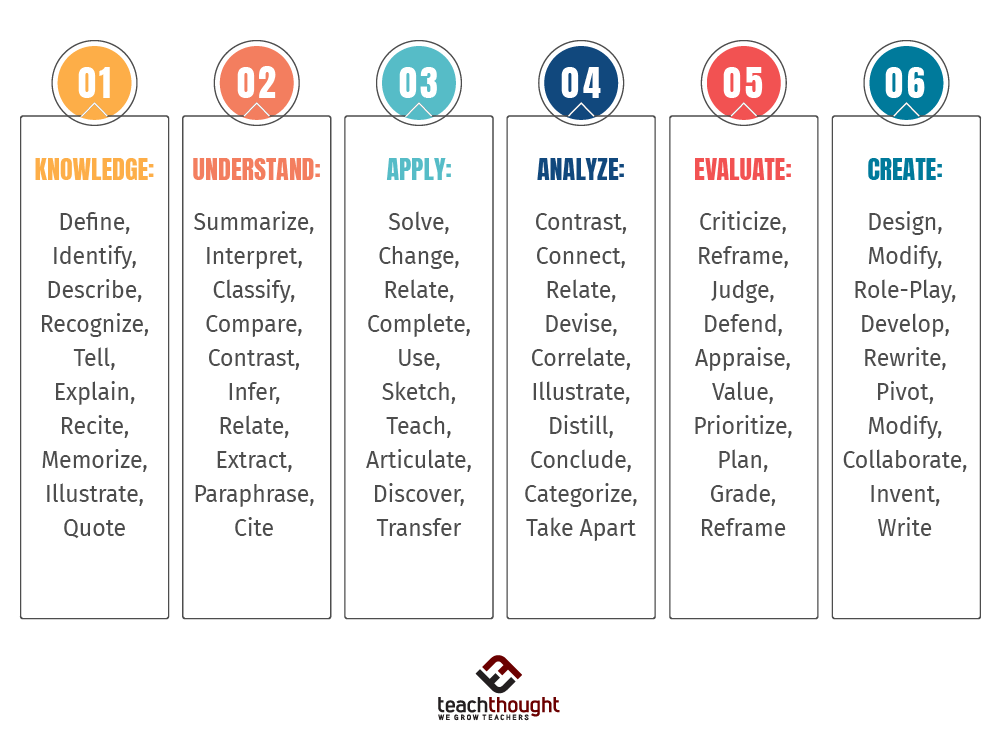
by TeachThought Workers
Bloom’s Taxonomy’s verbs–also referred to as energy verbs or considering verbs–are terribly highly effective educational planning instruments.
In truth, along with ideas like backward design and energy requirements, they’re one of the helpful instruments a teacher-as-learning-designer has entry to. Why?
As analysis has recommended, they can be utilized for evaluation design, curriculum design, lesson planning, personalizing and differentiating studying, and virtually every other ‘factor’ a instructor–or scholar–has to do.
For instance, if an ordinary asks college students to deduce and show an creator’s place utilizing proof from the textual content, there’s rather a lot constructed into that type of job. First, a scholar has to have the ability to outline what an ‘creator’s place’ is and what ‘proof from the textual content’ means (Information-level). They’ll then want to have the ability to summarize that very same textual content (Understanding-level), interpret and infer any arguments or positions (Analyze-level), consider inherent claims (Consider-level), after which write (Create-level) a response that demonstrates their considering.
Although the chart beneath reads left to proper, it’s preferrred to think about it as a type of incline, with Information on the backside, and Create on the high. You might not at all times want this sort of device to ‘unpack’ requirements and establish a attainable studying sequence, but it surely additionally works ideally as an evaluation design device. If college students can persistently work with the subject within the columns to the suitable–designing, recommending, differentiating, evaluating and contrasting, and so forth, then they probably have a agency grasp on the fabric.
It’s also possible to learn extra about Bloom’s Revised Taxonomy (or Bloom’s up to date Taxonomy) for those who’re so inclined.
Whereas we’ve shared Bloom’s Taxonomy posters earlier than, the simplicity and clear design of the chart format make it a bit extra purposeful–even helpful handy to the scholars themselves as a hole-punch-and-keep-it-in-your-journal-for-the-year type of useful resource. It additionally makes a robust self-directed studying device. Begin on the left, and, roughly, transfer proper.
Additionally see Bloom’s Digital Verbs For Know-how-Wealthy Instructing for a model of Bloom’s designed for digital duties and instruments.
For a visible model of this framework, see Bloom’s Digital Taxonomy Chart.
Information: Outline, Determine, Describe, Acknowledge, Inform, Clarify, Recite, Memorize, Illustrate, Quote, State, Match, Acknowledge, Choose, Look at, Find, Recite, Enumerate, Document, Checklist, Quote, Label
Perceive: Summarize, Interpret, Classify, Evaluate, Distinction, Infer, Relate, Extract, Paraphrase, Cite, Talk about, Distinguish, Delineate, Lengthen, Predict, Point out, Translate, Inquire, Affiliate, Discover Convert
Apply: Remedy, Change, Relate, Full, Use, Sketch, Educate, Articulate, Uncover, Switch, Present, Exhibit, Contain, Dramatize, Produce, Report, Act, Reply, Administer, Actuate, Put together, Manipulate
Analyze: Distinction, Join, Relate, Devise, Correlate, Illustrate, Distill, Conclude, Categorize, Take Aside, Drawback-Remedy, Differentiate, Deduce, Conclude, Devise, Subdivide, Calculate, Order, Adapt
Consider: Criticize, Reframe, Decide, Defend, Appraise, Worth, Prioritize Plan, Grade, Reframe, Revise, Refine, Grade, Argue, Help, Evolve, Resolve, Re-design, Pivot
Create: Design, Modify, Position-Play, Develop, Rewrite, Pivot, Modify, Collaborate, Invent, Write, Formulate, Invent, Think about
100+ Bloom’s Taxonomy Verbs For Important Pondering



